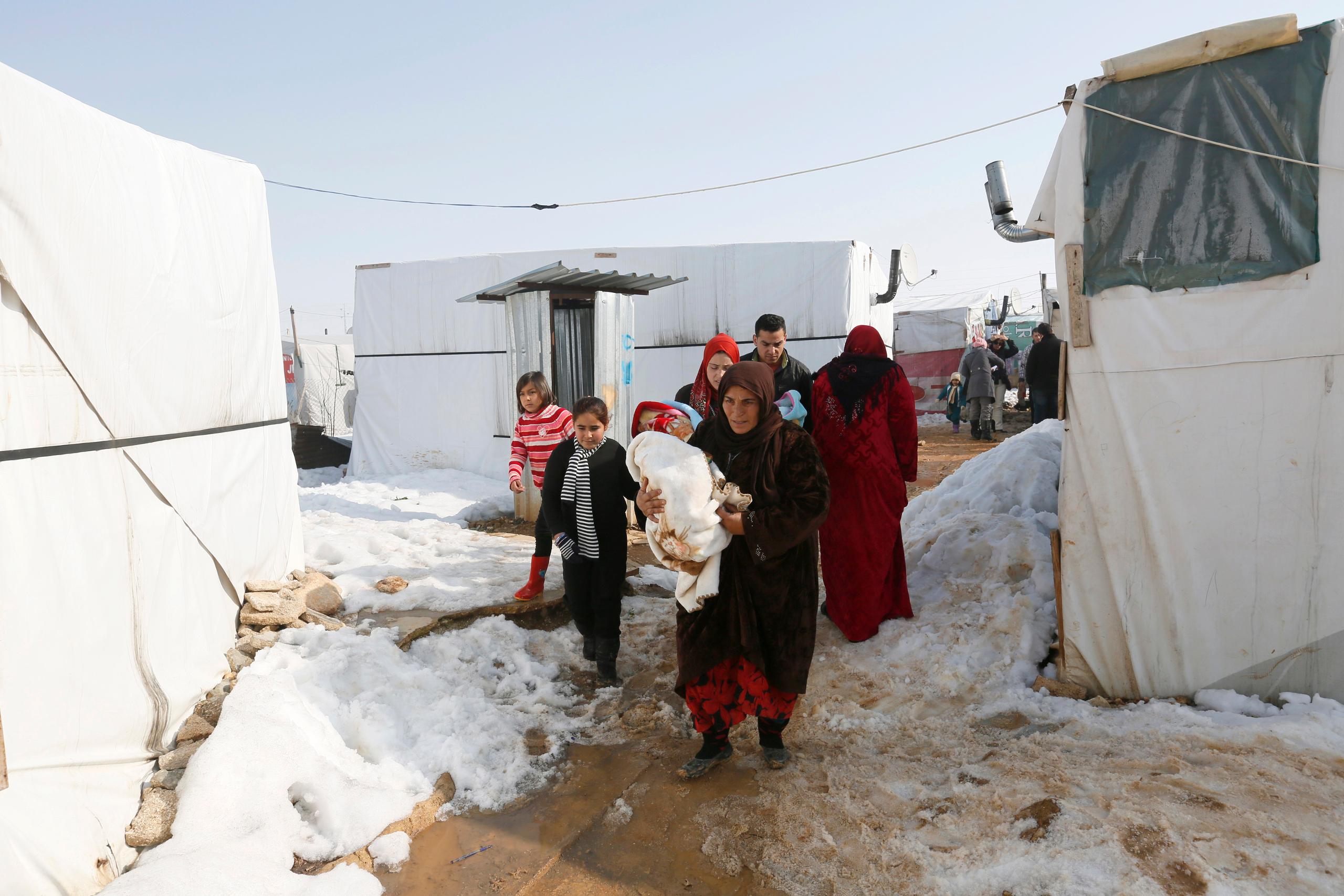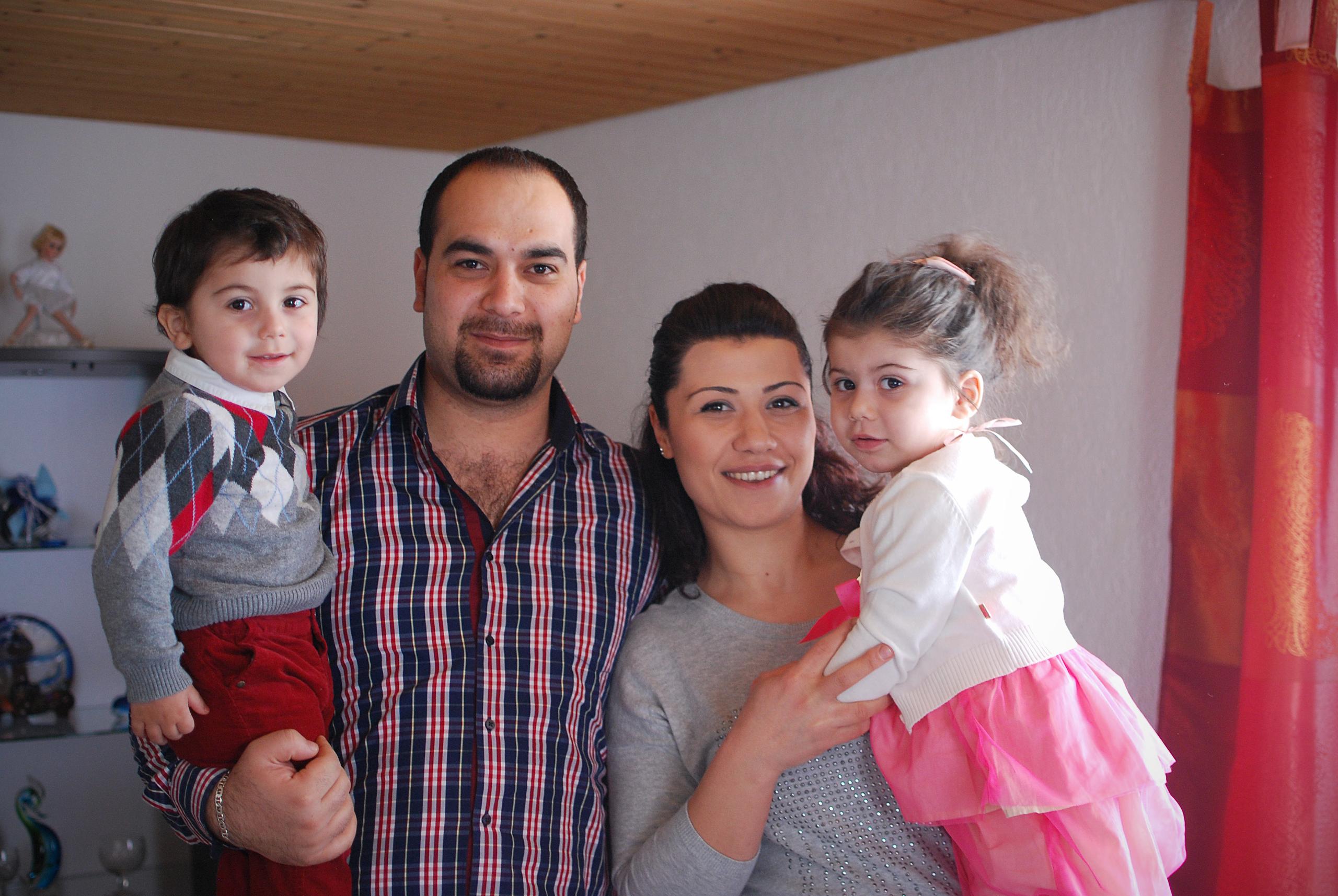Helping Syria: give more aid or accept more refugees?

The number of refugees and internally displaced persons continues to rise worldwide. The war in Syria is one of the main reasons. While Lebanon and Jordan are strained to the limit by the influx of refugees, the question being asked in Switzerland is how can help be intensified.
“There were 350 of us on the boat. They crammed us in with kicks. Everyone was seasick. We ate nothing for four-and-a-half days. I noticed the boat was taking in water. Luckily an oil tanker came by which called the navy to help.”
This is what happened to 30-year-old Neroz Kahil. She can never forget the scenes before her arrival in Italy in September 2013. Together with her family she had left the Syrian city of Aleppo eight months before. A bomb that fell on a mosque nearby partly destroyed her house.
First she fled to Lebanon, then Turkey and on to Greece. Kahil paid people smugglers $13,000 (CHF12,100) for the journey to Europe. With tears in her eyes, she describes leaving two of her children, aged five and ten, behind in Lebanon.
“My ex-husband didn’t want to go to Europe. He said to me: ‘You can take two children with you. Choose them.’ That was the worst moment of my life.”
In Italy, Kahil took a train for Switzerland. The smugglers had advised her to do that. “I actually wanted to go to Germany. There was no specific reason, but all the other Syrians I met wanted to go to Germany.”
When she arrived in Ticino, a policeman was the first to look after her. “He was very friendly and even brought us a pizza,” she remembers. “For us, that was the first sign of humanity we had seen since we left Syria. I said to myself, now that’s enough. I was tired of travelling from one country to the next. My daughters were exhausted too. And so we stayed in Switzerland.“
Syrian Exodus
Kahil is just one example of an unending stream of refugees. According to the latest reports from the UN refugee agency UNHCR, 5.5 million people were forced to flee in the first half of 2014 alone. This is in addition to the 51.2 million people counted as refugees or internally displaced persons (internal refugees) at the end of 2013.
At three million people, Syrians became the largest population of refugees in June 2014. Just two years ago Syrians were not even among the top 30 nationalities in refugee statistics.
The statistics show a series of other worrying developments. It is mainly the poorest countries that are shouldering the economic and social costs of refugee assistance. Just 4% of Syrian refugees have made it to Europe, according to Amnesty International.
In the past three years some 150,000 people from Syria have applied for asylum in European Union countries. The same number of refugees reached Turkey in the space of one week after Islamic State militants attacked the city of Kobane.
Syria’s neighbouring countries are at the limit of their capacity to accommodate refugees, also because the international community has failed to provide adequate assistance, according to the UNHCR.
A report published at the beginning of January shows that two-thirds of Syrian refugees in Jordan are living under the poverty line. Meanwhile in Lebanon, refugees now make up a quarter of the population. And their situation is just as critical.
“We had been living in one room for six months. There was only enough power for one lamp. My ex-husband was working but not receiving any salary. I stayed at home with the children. I had no money to send them to school,” Kahil recalls of her time in Lebanon. But the worst thing was the aversion shown by the Lebanese towards the refugees from Syria. “The Lebanese did not want us.”

More
Starting over in Switzerland
More help
Since the war began four years ago, Switzerland has taken in around 9,000 Syrian refugees. About half this number were able to come to Switzerland thanks to relaxed entry conditions. In autumn 2013, the government decided to take a contingent of 500 particularly vulnerable refugees over three years.
However, the Swiss government maintains that “assistance on the ground is the priority”. To date, CHF128 million ($138 million) has been made available. Apart from providing emergency aid, the Swiss have also financed projects for Lebanese families who have taken in Syrian refugees. Money has also gone towards building schools in Lebanon and Jordan.
According to the Swiss Refugee Agency, these measures are not sufficient – Switzerland and the rest of Europe has to do more.
“There are particularly vulnerable people, especially mothers alone with children, the elderly and those who are sick, who can only be saved if they are brought to Europe,” the agency’s Stefan Frey told swissinfo.ch.
Frey says there is enough room in Switzerland for refugees. “In the tourism cantons, there is potential accommodation, such as former hotels, that can easily be renovated. Industry and business premises can also be suitable. Luxury accommodation is not needed here. It is about saving human lives.”
‘Pitiful condition’
Heinz Brand, an expert on migration issues for the conservative right Swiss People’s Party, which is known for its restrictive asylum policy, is in favour of provisionally accepting the Syrian refugees currently going through the asylum process – but only for as long as the conflict in Syria continues.
This system, which was used during the conflict in the former Yugoslavia, makes it possible to react and offer protection quickly.
Brand went to Lebanon at the end of December to see the situation on the ground with his own eyes. “The refugee camps are in a pitiful condition. The situation is incredibly sad, without a future or hope,” he told swissinfo.ch.

More
Here, but facing an uncertain future
He says this personal experience has not really changed his view of the refugee problem. He supports the idea of introducing contingents to allow very sick people to be accepted and family reunification to take place. At the same time he is convinced that providing assistance in the region is the most efficient way to help.
“Most of the people in refugee camps who I spoke to told me that they did not want to come to Europe. They want to stay near their own country, to keep an eye on developments there and to be able to return home as soon as the situation allows it,” Brand said.
Changed view
“I think both strategies are necessary,” Roger Zetter, professor emeritus at the centre for migration studies at the University of Oxford, told swissinfo.ch.
Zetter believes that European countries have to do more to make it possible for Syrian refugees to resettle. “It is known that many refugees seek the opportunity for a new beginning because they don’t see any future in their region. But only one in ten refugees manages this.”
Accept 100,000 Syrians?
In an open letter to the Swiss president at the beginning of January, 28 organisations urged Switzerland to accommodate 100,000 Syrian refugees and ease visa restrictions for Syrians. The chances of success of this appeal are slim. Heinz Brand sees the appeal as “unrealistic and cynical”. According to the NZZ am Sonntag newspaper, Switzerland is currently considering whether to take part in an EU Commission pilot project to accept a contingent of 10,000 Syrian refugees.
Zetter produced a report “Protection for the persecuted”, for the federal commission for migration issues. He takes the view that “the distribution of Syrian refugees in Europe must be considered”. Up to now a handful of countries, including Germany and Sweden, have taken in the majority of the refugees.
In relation to assistance on the ground, Zetter argues for a new approach. “We have to move away from emergency aid and start thinking long term. We have to reflect on how to support refugees without the local population being disadvantaged through the huge pressure on the health and school systems.”
“I feel respected here”
After the call by the UNHCR and several peace and refugee organisations for Switzerland to take in more Syrians (see box), the government is now considering how to intensify aid for refugees.
By the end of February the relevant ministries have to prepare proposals on how aid on the ground can be improved. Also to be examined, under what conditions Switzerland could accept more refugees.
While the political wheels are grinding, Kahil is waiting for a decision on her asylum application, submitted more than a year ago. She is currently living in Fribourg and learning French. Thanks to the help of the Red Cross, her two other children were able to come to Switzerland. All four children are now attending school.
“I was lucky, because I met people who helped me. I don’t want to leave Switzerland. It’s nothing to do with the money or the services. I just feel respected here – as a person.”
Increase in asylum applications
The number of new asylum seekers registered in Switzerland last year was 23,765, an increase of 11% on the 2013 figure. The largest nationality group were Eritreans, with 6,923 applications, followed by Syrians (3,819) and Sri Lankans (1,277). The Swiss increase was modest in comparison to the overall figures for Europe, where the number of registered asylum seekers in 2014 reached 600,000, an increase of 35% on 2013. The asylum applications in Switzerland equate to 4% of the European total. Asylum was granted in 26% of cases last year. In 2013 the recognition rate was just 15%.
(Source : Federal Office for Migration)
(Translated from French by Clare O’Dea)

In compliance with the JTI standards
More: SWI swissinfo.ch certified by the Journalism Trust Initiative











You can find an overview of ongoing debates with our journalists here . Please join us!
If you want to start a conversation about a topic raised in this article or want to report factual errors, email us at english@swissinfo.ch.